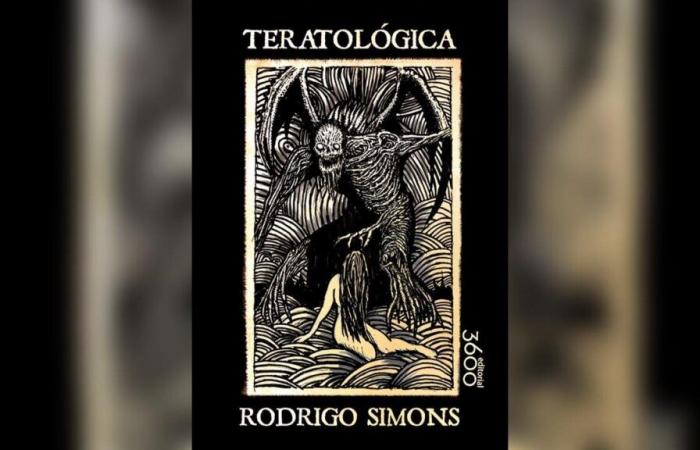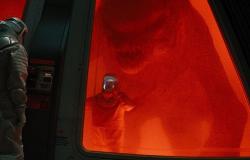An innatural comfort accompanies the reading of the word Logos (study) next to the word terrates (nightmare or monster). It gives me the false assurance that the academic approach to the deformity subtracts strength from the inexplicable scratch that appears on the canvas of certainty. But the monsters that Conjura Rodrigo Simons escape that study. Despite having them in the hands, arrested between pages, conjured through letters, between the dark tapas of the book, they inhabit and breathe, move and only need to feed on a reading to take our breath of life and walk again among us. The author is one of the great exponents of the terror of Cruceño, exercised since his own admiration for the unknown and perfected in his narrative work.
None of the stories are the same or follow the same format. The narrative on the shoulder of the first person, the story of the events of the past of the third person, the tragedy of the epistolary genre of having the last memory of the facts that brought misfortune, the suffocating and irresistible strength that makes us review a narrative found, Rodrigo Simons uses them all, mixes them to generate a monster of multiple extremities and gives us the certainty of not having a comfort shelter the horrors of reality. Its form, as its background, start from discomfort and get to fruition based on stories with natural and scary structures. In his world, fiction is normal, and normal terrify the one who looks too much to take an eye. But the floor is from Movedizas Arenas, and like the worst curses, once one begins, it must end as it gives.
Teratological is a storybook in which the pleasure of reading is invested. In all his stories, there comes a time when one stops reading attentive, with reading comprehension, learning words, and goes on to read horrified, trying to accelerate reading without losing trace as if he fled along a dirt road at night, anxious to reach the alleged security of home but without daring to look back so that the monster does not reach you, so that the curse does not conjure, so that the night he passes. But the night never passes.
From the dedication the book hints the surprise, the stupor. “What always did the Rodrigo.”
The walk through the index, which is always to look out the window before furtively break into the book, is a story of horror itself that as the facade of abandoned houses warns about its content. This place is not a common book. There is no refuge or ethereal space. In these letters the monsters live, the unnamed beings, those who feed on our flesh and drink our breath. And yet (or maybe for that) one decides to start reading.
“Appeared on the roof”: The protagonist of this story discovers the corners of communion with the spirits. It develops with mastery in that roulette of pacts that are not sealed with a handshake, but with the decree of the desires of those who do not have flesh and blood. But about the word of the dead and the commitment of the living, there is more than a handshake. Simons uses hard and bloody spaces, very real physical places for the reader to remember that fiction does not always need to fly to imaginary kingdoms. Sometimes it is made of things that happened. Sometimes pain is what we have most in common among us.
“The night of the vulture”: in the tour of cureing her son of an evil that has no explanation, a mother learns that no one can do anything against fate, and that the cruel games of chance are the only safe spell. We prepare against misfortune, we put ourselves with magic and amulets, but nothing can be done against chance and its capricious designs. Those particular cults, which should not be bad for anyone, worsen our diseases. And we discover that some priests poison us.
“Zombies and Stand Up”: For this height of the book you’ve already realized, you know with certainty that nothing will go well. That the author’s horror can stain all other genres without problem. In this case, the three stories that this matrioska of horror assemble. And there are three short stories, huge in their misfortune, conjugated in tragedy. The story within the story within history. They do not need monsters to leave you uncomfortable in the place where unfortunately you began to read. The father who dreams of the son who dreams of the father who dreams of the son?, Himself?, To his father? It bothers me that the perfect pieces of words serve to leave me deliberately restless to the tragedy of the narrative. And this story does it.
“Children of the jungle”: a composition of thriller and tragic adventure. As the author knows how to turn his own box of surprises, and in this case the monster does not come from the Averno, he did not escape from a grave, he is not another human like us. It is the dense, immense and overwhelming jungle that serves as a monster of this story. A monster that is not still as it appears, and that although it cannot be explained, calls the unsuspecting to enter their mouths.
“Nocturnal for a working man”: the beginning already liquidates you. That the last message of the protagonist has a part only for his wawas, who does not want them to listen to the rest, already puts the tone of what will happen. It is the terrible thing in epistolary narratives, in the last message of a lost man. The details that extract from a fiction from the imagination to sow it in reality with a place, an hour, a husband, a woman and a monster. Discomforts the comfort of knowing reader, and burns you with the certainty of knowing you witness. And Simons knows. Use it. This is the story of unstoppable terror. Nothing ends well. Waiver of terror conventions to give us something worse: a malicious tragedy with metamorphosis.
“Neighbors”: I would not presume to meet my neighbors, maybe or have seen them. But if I have a more or less accurate idea of what they are. Because they are like me, or they should be something similar to me, right? I already wrote that nothing is what it seems in Rodrigo’s stories. In this, the rule takes another turn, a tragic turn in its history, but to surprise, almost with pride, the reader with the author’s ability to play with the possibilities of the narration. With the tools that are no longer the usual, but are used for amusement of the narrator and astonishment of one who does not know if he is reading or if they are reading it.
“The rain and the night”: apart from the skill of making a short story, and of doing it very well, at this point in the book one is already convinced that it does not matter what the text is, in appearance at least, because with Rodrigo Simons there will never be a normal course. Even the most routine activities, which bores us from our common day, becomes spooky spells. And you end up asking for the boring to come back, not to leave, that we will never complain about the ordinary of our lives. Let our other option be the unknown horror of not knowing what entered our house.
“Dying is not the answer”: in the bloody genre Gore, the blow to the reader comes from an addition of living ingredients, fillets with butcher hand and cooked to boil to physically question the reader about the integrity of his flesh. This is usually a construction of massacre and blood made in pages and pages for morbid delight of the cultists of the genre. Rodrigo Simons gets it here with a line. A prayer. He doesn’t need more to surprise the reader and show him that this is not all he has in his grave bag. And be careful, that he does not stop him to continue taking a final turn to this story, which twists his plot as his neck twists. As in all its stories.
“Double funeral”: as the stories are actually Ríos, in this story the Rodrigo takes three rivers to an amazing channel. The love that kills, the love that doubts, the love that dies. They are common, but the mark of their tragedy is the denominator. A mastery of the short story who, like good poisons, only needs a drop to kill.
“The tree house”: just as children’s games are the most serious for them, we should also take them seriously. We do not know what they hide, what plans, what presences. We approach the inexperience of adults, thinking of understanding that world that we believe so simple. But that is the horror of this story, that you think it can’t kill you.
Rodrigo Simons’s writing meets that maximum of the great stories: it is not a battle for long rounds, he beats you for Knock out. The final blow comes at different times in each story, but that is what makes it so enjoyable to read it. There is never a predictable formula or routine in Rodrigo’s writing that allows us to present the horror or tragedy that is coming. It’s there, it’s your only certainty. And you know that he observes you, waiting for the moment to jump from the bushes. But you don’t know when. The only thing you have left in your hands is the comfort that every story has an end. And just a story you close the fast book, convinced that you finished reading and that (for now) the monsters stayed between pages. But while you look at your immediate surroundings, you have the feeling under the skin that you took something with you. You don’t know if you have a woman’s face, beast fangs, soul breath or curse spell, but you are with you. The lid of the book looks at you with empty eyes, black basins that hide their truth in shadows.






